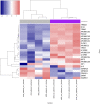Human Primary Macrophages Derived In Vitro from Circulating Monocytes Comprise Adherent and Non-Adherent Subsets with Differential Expression of Siglec-1 and CD4 and Permissiveness to HIV-1 Infection
- PMID: 29123518
- PMCID: PMC5662875
- DOI: 10.3389/fimmu.2017.01352
Human Primary Macrophages Derived In Vitro from Circulating Monocytes Comprise Adherent and Non-Adherent Subsets with Differential Expression of Siglec-1 and CD4 and Permissiveness to HIV-1 Infection
Abstract
Macrophages are a major target for human immunodeficiency virus type 1 (HIV-1) infection. However, macrophages are largely heterogeneous and may exhibit differences in permissiveness to HIV-1 infection. This study highlights the interplay of macrophage heterogeneity in HIV-1 pathogenesis. We show that monocyte-derived macrophages (MDMs) could be divided into two distinct subsets: CD14+Siglec-1hiCD4+ (non-adherent MDM) and CD14+Siglec-1LoCD4- (adherent MDM). The CD14+Siglec-1hiCD4+MDM subset represented the smaller proportion in the macrophage pool, and varied among different donors. Fractionation and subsequent exposure of the two MDM subsets to HIV-1 revealed opposite outcomes in terms of HIV-1 capture and infection. Although the CD14+Siglec-1hiCD4+MDM captured significantly more HIV-1, infection was significantly higher in the CD14+Siglec-1LoCD4-MDM subset. Thus, CD14+Siglec-1hiCD4+MDM were less permissive to infection. Depletion of CD14+Siglec-1hiCD4+MDM or a decrease in their percentage, resulted in increased infection of MDM, suggestive of a capacity of these cells to capture and sequester HIV-1 in an environment that hinders its infectivity. Increased expression of innate restriction factors and cytokine genes were observed in the non-adherent CD14+Siglec-1hiCD4+MDM, both before and after HIV-1 infection, compared to the adherent CD14+Siglec-1LoCD4-MDM. We speculate that the differential expression of gene expression profiles in the two macrophage subsets may provide an explanation for the differences observed in HIV-1 infectivity.
Keywords: CD4; RNA-Seq; Siglec-1; human immunodeficiency virus type 1; monocyte-derived macrophages; restriction factors.
Figures





Similar articles
-
Interaction Between Macrophage Migration Inhibitory Factor and CD74 in Human Immunodeficiency Virus Type I Infected Primary Monocyte-Derived Macrophages Triggers the Production of Proinflammatory Mediators and Enhances Infection of Unactivated CD4+ T Cells.Front Immunol. 2018 Jun 27;9:1494. doi: 10.3389/fimmu.2018.01494. eCollection 2018. Front Immunol. 2018. PMID: 29997630 Free PMC article.
-
Carbohydrate-binding agents (CBAs) inhibit HIV-1 infection in human primary monocyte-derived macrophages (MDMs) and efficiently prevent MDM-directed viral capture and subsequent transmission to CD4+ T lymphocytes.Virology. 2008 Jan 20;370(2):382-91. doi: 10.1016/j.virol.2007.08.033. Epub 2007 Oct 24. Virology. 2008. PMID: 17928023
-
Increased frequency and cell death of CD16+ monocytes with Mycobacterium tuberculosis infection.Tuberculosis (Edinb). 2011 Sep;91(5):348-60. doi: 10.1016/j.tube.2011.04.002. Epub 2011 May 28. Tuberculosis (Edinb). 2011. PMID: 21621464
-
[Deep lung--cellular reaction to HIV].Rev Port Pneumol. 2007 Mar-Apr;13(2):175-212. Rev Port Pneumol. 2007. PMID: 17492233 Review. Portuguese.
-
The macrophage response to HIV-1: Intracellular control of X4 virus replication accompanied by activation of chemokine and cytokine synthesis.J Neurovirol. 2002 Dec;8(6):599-610. doi: 10.1080/13550280290100923. J Neurovirol. 2002. PMID: 12476353 Review.
Cited by
-
Dopamine-driven increase in IL-1β in myeloid cells is mediated by differential dopamine receptor expression and exacerbated by HIV.J Neuroinflammation. 2025 Mar 23;22(1):91. doi: 10.1186/s12974-025-03403-9. J Neuroinflammation. 2025. PMID: 40122818 Free PMC article.
-
Army liposome formulation containing QS-21 render human monocyte-derived macrophages less permissive to HIV-1 infection by upregulating ABOBEC3A.Sci Rep. 2022 May 9;12(1):7570. doi: 10.1038/s41598-022-11230-8. Sci Rep. 2022. PMID: 35534646 Free PMC article.
-
CD34 Identifies a Subset of Proliferating Microglial Cells Associated with Degenerating Motor Neurons in ALS.Int J Mol Sci. 2019 Aug 9;20(16):3880. doi: 10.3390/ijms20163880. Int J Mol Sci. 2019. PMID: 31395804 Free PMC article.
-
Modeling COVID-19 with Human Pluripotent Stem Cell-Derived Cells Reveals Synergistic Effects of Anti-inflammatory Macrophages with ACE2 Inhibition Against SARS-CoV-2.Res Sq [Preprint]. 2020 Sep 15:rs.3.rs-62758. doi: 10.21203/rs.3.rs-62758/v2. Res Sq. 2020. PMID: 32839764 Free PMC article. Preprint.
-
Differential effects of macrophage subtypes on SARS-CoV-2 infection in a human pluripotent stem cell-derived model.Nat Commun. 2022 Apr 19;13(1):2028. doi: 10.1038/s41467-022-29731-5. Nat Commun. 2022. PMID: 35440562 Free PMC article.
References
-
- Igarashi T, Brown CR, Endo Y, Buckler-White A, Plishka R, Bischofberger N, et al. Macrophage are the principal reservoir and sustain high virus loads in rhesus macaques after the depletion of CD4+ T cells by a highly pathogenic simian immunodeficiency virus/HIV type 1 chimera (SHIV): implications for HIV-1 infections of humans. Proc Natl Acad Sci U S A (2001) 98(2):658–63.10.1073/pnas.98.2.658 - DOI - PMC - PubMed
Grants and funding
LinkOut - more resources
Full Text Sources
Other Literature Sources
Molecular Biology Databases
Research Materials

